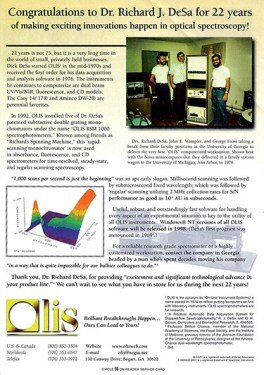The smart Trick of Circular Dichroism That Nobody is Talking About
Table of ContentsThe Single Strategy To Use For Uv/visHow Uv/vis can Save You Time, Stress, and Money.The smart Trick of Circularly Polarized Luminescence That Nobody is DiscussingUnknown Facts About Uv/visNot known Facts About Uv/vis/nir

Spectrophotometry is a tool that hinges on the quantitative analysis of molecules depending on how much light is taken in by colored substances.
How Uv/vis/nir can Save You Time, Stress, and Money.
A spectrophotometer is typically utilized for the measurement of transmittance or reflectance of options, transparent or opaque solids, such as polished glass, or gases. Lots of biochemicals are colored, as in, they take in visible light and therefore can be determined by colorimetric treatments, even colorless biochemicals can typically be transformed to colored compounds appropriate for chromogenic color-forming responses to yield substances appropriate for colorimetric analysis.: 65 Nevertheless, they can likewise be developed to measure the diffusivity on any of the listed light ranges that typically cover around 2002500 nm using different controls and calibrations.
An example of an experiment in which spectrophotometry is used is the determination of the balance constant of a service. A certain chemical reaction within a solution might occur in a forward and reverse instructions, where reactants form products and items break down into reactants. Eventually, this chemical reaction will reach a point of balance called a stability point.
Circularly Polarized Luminescence Things To Know Before You Get This
The amount of light that goes through the option is a sign of the concentration of specific chemicals that do not allow light to pass through. The absorption of light is because of the interaction of light with the electronic and vibrational modes of molecules. Each type of molecule has a specific set of energy levels connected with the makeup of its chemical bonds and nuclei and therefore will take in light of particular wavelengths, or energies, resulting in unique spectral residential or commercial properties.
They are commonly utilized in numerous markets including semiconductors, laser and optical production, printing and forensic assessment, as well as in labs for the study of chemical compounds. Spectrophotometry is frequently used in measurements of enzyme activities, determinations of protein concentrations, decisions of enzymatic kinetic constants, and measurements of ligand binding reactions.: 65 Ultimately, a spectrophotometer is able to identify, depending on the control or calibration, what substances are present in a target and exactly how much through computations of observed wavelengths.
This would come as a service to the previously produced spectrophotometers which were unable to take in the ultraviolet properly.
The 4-Minute Rule for Spectrophotometers
It would be discovered that this did not offer acceptable outcomes, therefore in Design B, there was a shift from a glass to a quartz prism which allowed for better absorbance results - UV/Vis/NIR (https://www.startus.cc/company/olis-clarity). From there, Design C was born with a change to the wavelength resolution which wound up having 3 systems of it produced
It irradiates the sample with polychromatic light which the sample soaks up depending upon its homes. Then it is transferred back by grating the photodiode selection which identifies the wavelength area of the spectrum. Considering that then, the creation and implementation of spectrophotometry devices has increased immensely and has ended up being one of the most innovative instruments of our time.

Not known Details About Spectrophotometers
Historically, spectrophotometers use a monochromator including a diffraction grating to produce the analytical spectrum. The grating can either be movable or fixed. If a single detector, such as a photomultiplier tube or photodiode is used, the grating can be scanned stepwise (scanning spectrophotometer) so that the detector can measure the light strength at each wavelength (which will correspond to each "step").
In such systems, the grating is repaired and the strength of each wavelength of light is determined by a various detector in the range. In addition, most contemporary mid-infrared spectrophotometers utilize a Fourier change strategy to get the spectral details - https://www.cgmimm.com/arts-entertainment/olis-clarity. This technique is called Fourier transform infrared spectroscopy. When making transmission measurements, the spectrophotometer quantitatively compares the fraction of light hop over to here that goes through a recommendation solution and a test solution, then digitally compares the intensities of the two signals and computes the portion of transmission of the sample compared to the reference standard.
